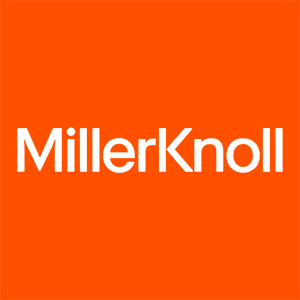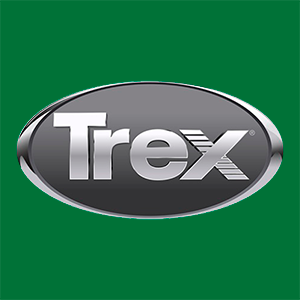
Quanex (NX)
We aren’t fans of Quanex. Its sales have underperformed and its low returns on capital show it has few growth opportunities.― StockStory Analyst Team
1. News
2. Summary
Why We Think Quanex Will Underperform
Starting in the seamless tube industry, Quanex (NYSE:NX) manufactures building products like window, door, kitchen, and bath cabinet components.
- Forecasted revenue decline of 2.3% for the upcoming 12 months implies demand will fall off a cliff
- Growth came at the expense of profits over the last five years as its substandard operating margin deteriorated even further
- A silver lining is that its annual revenue growth of 17.1% over the past five years was outstanding, reflecting market share gains this cycle


Quanex doesn’t meet our quality standards. We see more attractive opportunities in the market.
Why There Are Better Opportunities Than Quanex
High Quality
Investable
Underperform
Why There Are Better Opportunities Than Quanex
Quanex’s stock price of $13.70 implies a valuation ratio of 6.8x forward P/E. This is a cheap valuation multiple, but for good reason. You get what you pay for.
Cheap stocks can look like great bargains at first glance, but you often get what you pay for. These mediocre businesses often have less earnings power, meaning there is more reliance on a re-rating to generate good returns - an unlikely scenario for low-quality companies.
3. Quanex (NX) Research Report: Q2 CY2025 Update
Building products company Quanex (NYSE:NX) beat Wall Street’s revenue expectations in Q2 CY2025, with sales up 76.7% year on year to $495.3 million. On the other hand, the company’s full-year revenue guidance of $1.82 billion at the midpoint came in 1.6% below analysts’ estimates. Its non-GAAP profit of $0.69 per share was 18.1% below analysts’ consensus estimates.
Quanex (NX) Q2 CY2025 Highlights:
- Revenue: $495.3 million vs analyst estimates of $492.6 million (76.7% year-on-year growth, 0.5% beat)
- Adjusted EPS: $0.69 vs analyst expectations of $0.84 (18.1% miss)
- Adjusted EBITDA: $70.3 million vs analyst estimates of $80.57 million (14.2% margin, 12.7% miss)
- The company dropped its revenue guidance for the full year to $1.82 billion at the midpoint from $1.85 billion, a 1.6% decrease
- EBITDA guidance for the full year is $235 million at the midpoint, below analyst estimates of $270.8 million
- Operating Margin: -54.7%, down from 8.4% in the same quarter last year
- Free Cash Flow Margin: 9.3%, down from 14.3% in the same quarter last year
- Market Capitalization: $918.4 million
Company Overview
Starting in the seamless tube industry, Quanex (NYSE:NX) manufactures building products like window, door, kitchen, and bath cabinet components.
The company is an original equipment manufacturer (OEM) for products in the building materials industry. Its customers, which include national and regional residential window, door, and cabinet manufacturers, come to the company to buy the components needed to build their respective products.
For example, Quanex offers products like energy-efficient flexible insulating glass spaces, extruded vinyl profiles, and window and door screens, which are all components needed to manufacture windows and doors. This market is called the fenestration component market, which just means parts for the windows and doors industry. The company also offers non-fenestration products, like solar panel sealants, trim moldings, decking, fencing, and water retention barriers.
The sale of its fenestration products makes up most of the company’s revenue. These products are sold, through direct marketing, to building product manufacturers and suppliers in the construction industry. Its revenue can be divided into four revenue-generating segments, with North American Fenestration sales leading the way, followed by European Fenestration, North American Cabinet Components, and the Unallocated Corporate and Others segment.
4. Home Construction Materials
Traditionally, home construction materials companies have built economic moats with expertise in specialized areas, brand recognition, and strong relationships with contractors. More recently, advances to address labor availability and job site productivity have spurred innovation that is driving incremental demand. However, these companies are at the whim of residential construction volumes, which tend to be cyclical and can be impacted heavily by economic factors such as interest rates. Additionally, the costs of raw materials can be driven by a myriad of worldwide factors and greatly influence the profitability of home construction materials companies.
Competitors of Quanex include JELD-WEN (NYSE:JELD) and private companies Pella and Anderson.
5. Revenue Growth
Reviewing a company’s long-term sales performance reveals insights into its quality. Any business can experience short-term success, but top-performing ones enjoy sustained growth for years. Over the last five years, Quanex grew its sales at an incredible 17.1% compounded annual growth rate. Its growth beat the average industrials company and shows its offerings resonate with customers.
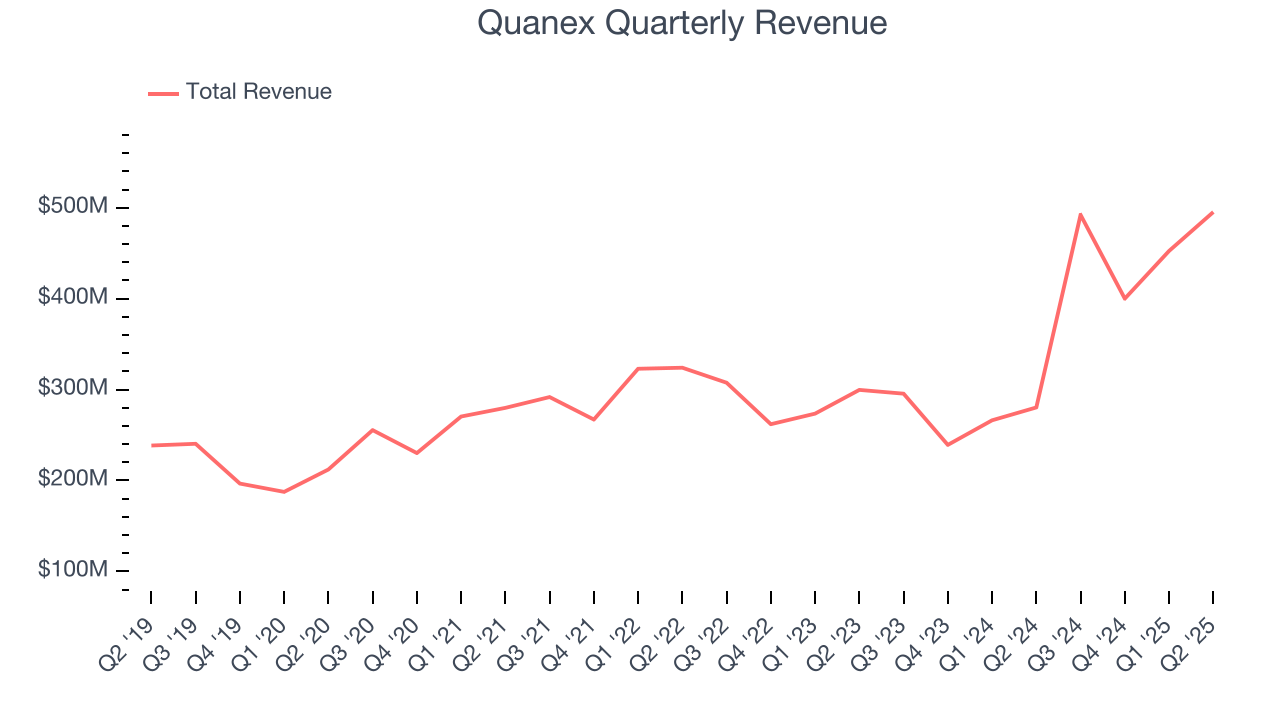
We at StockStory place the most emphasis on long-term growth, but within industrials, a half-decade historical view may miss cycles, industry trends, or a company capitalizing on catalysts such as a new contract win or a successful product line. Quanex’s annualized revenue growth of 26.9% over the last two years is above its five-year trend, suggesting its demand was strong and recently accelerated. 
We can better understand the company’s revenue dynamics by analyzing its most important segments, Fenestration and Cabinet Components, which are 34.4% and 10.4% of revenue. Over the last two years, Quanex’s Fenestration revenue (window and door components, North America only) averaged 2.9% year-on-year declines while its Cabinet Components revenue (cabinet parts, North America only) averaged 6.6% declines. 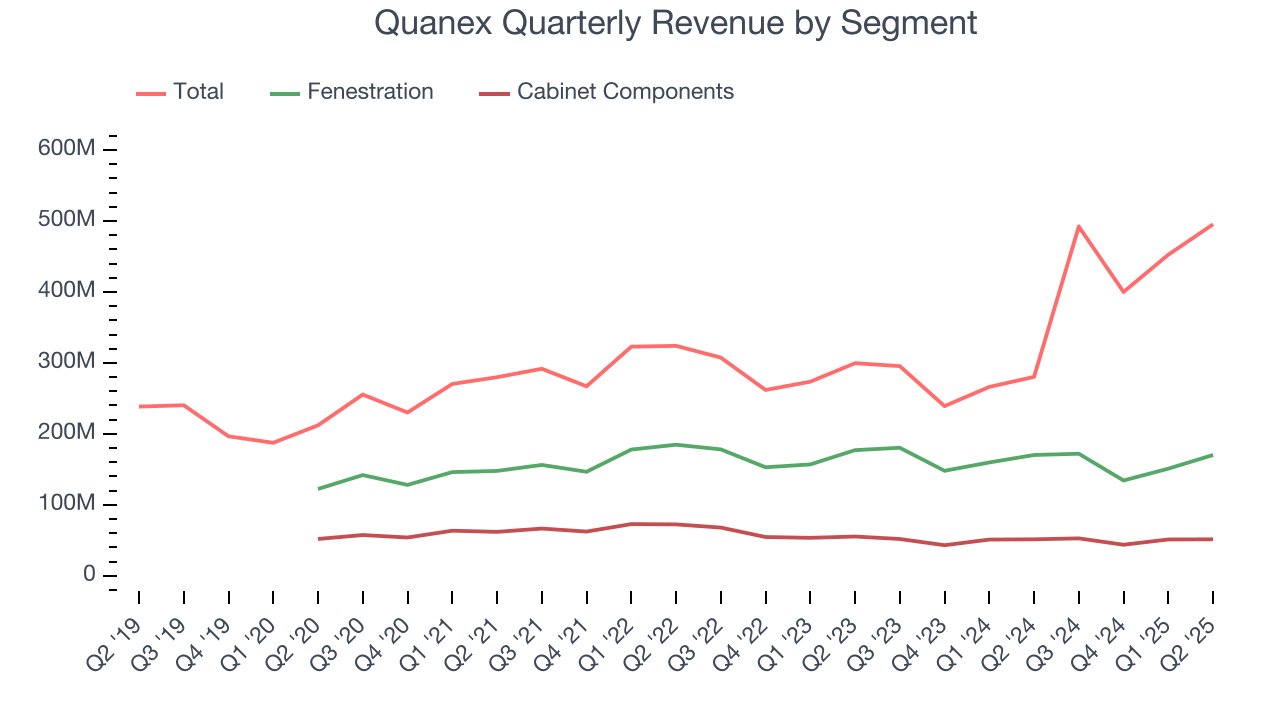
This quarter, Quanex reported magnificent year-on-year revenue growth of 76.7%, and its $495.3 million of revenue beat Wall Street’s estimates by 0.5%.
Looking ahead, sell-side analysts expect revenue to grow 2.5% over the next 12 months, a deceleration versus the last two years. This projection doesn't excite us and implies its products and services will face some demand challenges.
6. Gross Margin & Pricing Power
Quanex has bad unit economics for an industrials company, giving it less room to reinvest and develop new offerings. As you can see below, it averaged a 24.1% gross margin over the last five years. That means Quanex paid its suppliers a lot of money ($75.89 for every $100 in revenue) to run its business. 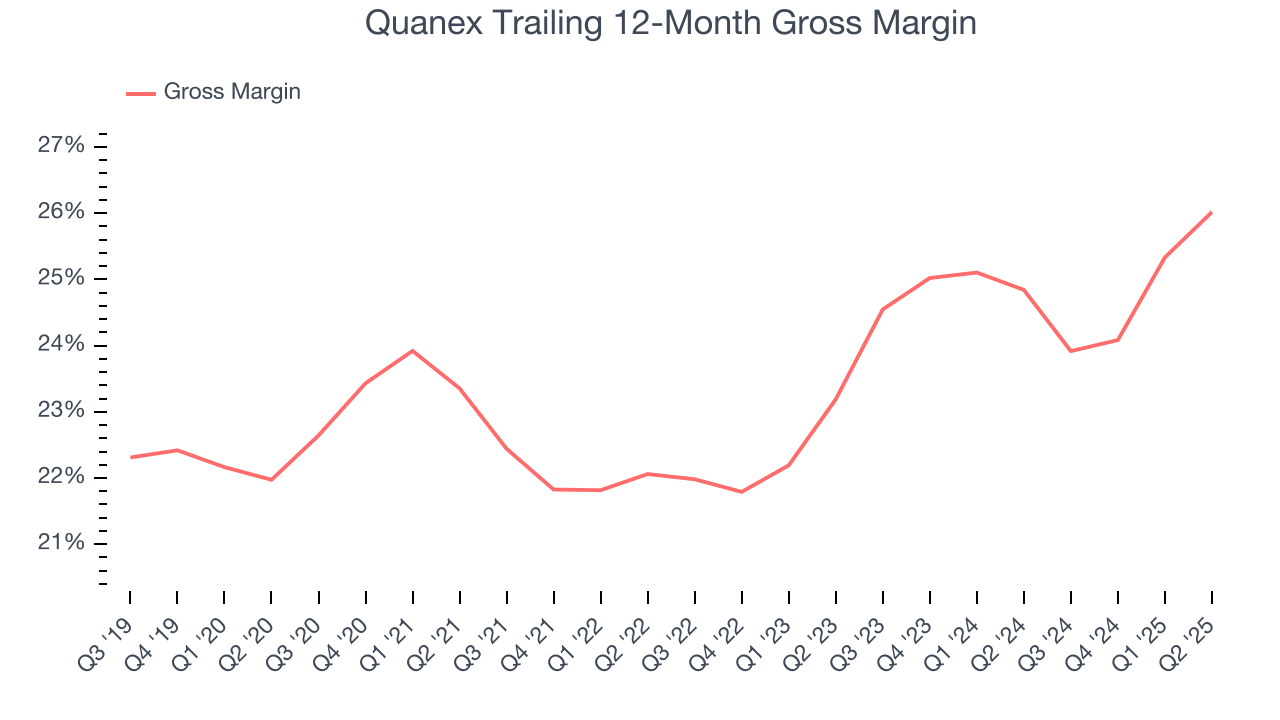
Quanex’s gross profit margin came in at 27.9% this quarter, marking a 2.6 percentage point increase from 25.3% in the same quarter last year. Quanex’s full-year margin has also been trending up over the past 12 months, increasing by 1.2 percentage points. If this move continues, it could suggest better unit economics due to more leverage from its growing sales on the fixed portion of its cost of goods sold (such as manufacturing expenses).
7. Operating Margin
Operating margin is one of the best measures of profitability because it tells us how much money a company takes home after procuring and manufacturing its products, marketing and selling those products, and most importantly, keeping them relevant through research and development.
Quanex was profitable over the last five years but held back by its large cost base. Its average operating margin of 2.4% was weak for an industrials business. This result isn’t too surprising given its low gross margin as a starting point.
Analyzing the trend in its profitability, Quanex’s operating margin decreased by 20.7 percentage points over the last five years. This raises questions about the company’s expense base because its revenue growth should have given it leverage on its fixed costs, resulting in better economies of scale and profitability. Quanex’s performance was poor no matter how you look at it - it shows that costs were rising and it couldn’t pass them onto its customers.
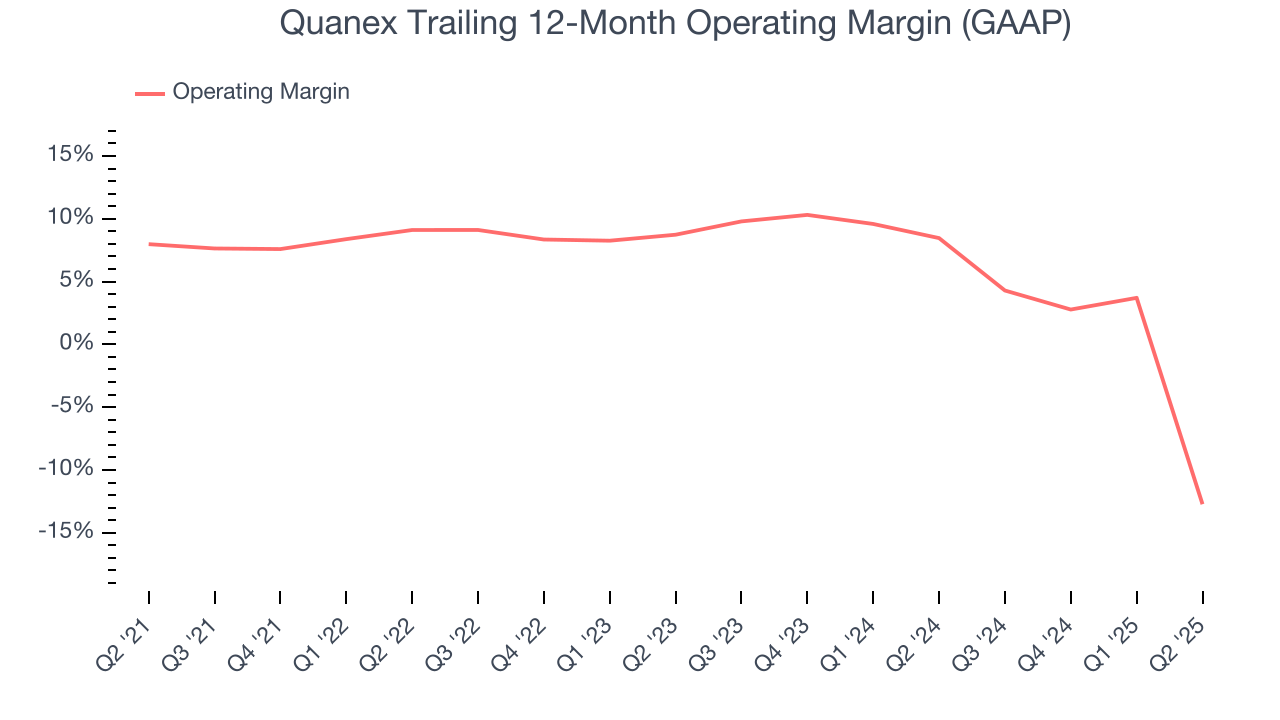
This quarter, Quanex generated an operating margin profit margin of negative 54.7%, down 63 percentage points year on year. Conversely, its revenue and gross margin actually rose, so we can assume it was less efficient because its operating expenses like marketing, R&D, and administrative overhead grew faster than its revenue.
8. Earnings Per Share
We track the long-term change in earnings per share (EPS) for the same reason as long-term revenue growth. Compared to revenue, however, EPS highlights whether a company’s growth is profitable.
Quanex’s spectacular 16.1% annual EPS growth over the last five years aligns with its revenue performance. This tells us it maintained its per-share profitability as it expanded.
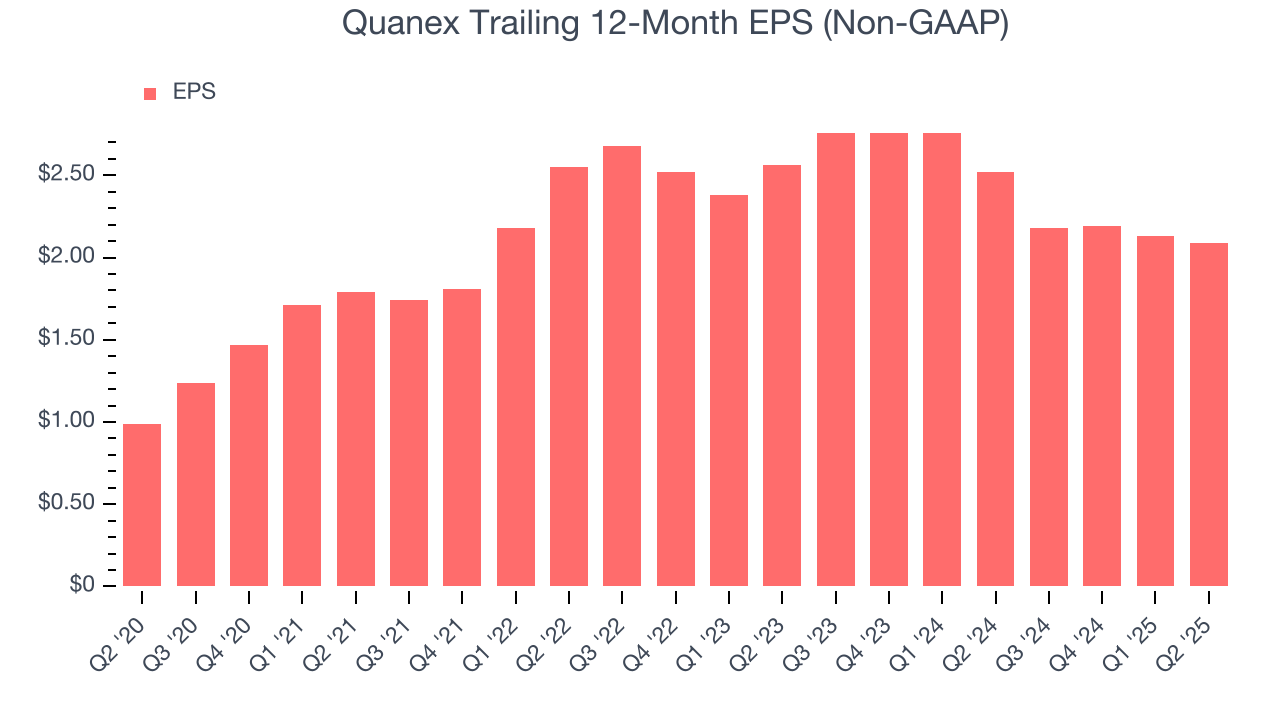
Like with revenue, we analyze EPS over a more recent period because it can provide insight into an emerging theme or development for the business.
Quanex’s two-year annual EPS declines of 9.6% were bad and lower than its 26.9% two-year revenue growth.
Diving into the nuances of Quanex’s earnings can give us a better understanding of its performance. Quanex’s operating margin has declined over the last two yearswhile its share count has grown 38.8%. This means the company not only became less efficient with its operating expenses but also diluted its shareholders. 
In Q2, Quanex reported adjusted EPS of $0.69, down from $0.73 in the same quarter last year. This print missed analysts’ estimates, but we care more about long-term adjusted EPS growth than short-term movements. Over the next 12 months, Wall Street expects Quanex’s full-year EPS of $2.09 to grow 32.9%.
9. Cash Is King
Free cash flow isn't a prominently featured metric in company financials and earnings releases, but we think it's telling because it accounts for all operating and capital expenses, making it tough to manipulate. Cash is king.
Quanex has shown mediocre cash profitability over the last five years, giving the company limited opportunities to return capital to shareholders. Its free cash flow margin averaged 5.8%, subpar for an industrials business.
Taking a step back, we can see that Quanex’s margin dropped by 6.2 percentage points during that time. This along with its unexciting margin put the company in a tough spot, and shareholders are likely hoping it can reverse course. If the trend continues, it could signal it’s in the middle of a big investment cycle.

Quanex’s free cash flow clocked in at $46.2 million in Q2, equivalent to a 9.3% margin. The company’s cash profitability regressed as it was 5 percentage points lower than in the same quarter last year, but it’s still above its five-year average. We wouldn’t read too much into this quarter’s decline because investment needs can be seasonal, causing short-term swings. Long-term trends are more important.
10. Return on Invested Capital (ROIC)
EPS and free cash flow tell us whether a company was profitable while growing its revenue. But was it capital-efficient? A company’s ROIC explains this by showing how much operating profit it makes compared to the money it has raised (debt and equity).
Quanex historically did a mediocre job investing in profitable growth initiatives. Its five-year average ROIC was 9.4%, somewhat low compared to the best industrials companies that consistently pump out 20%+.
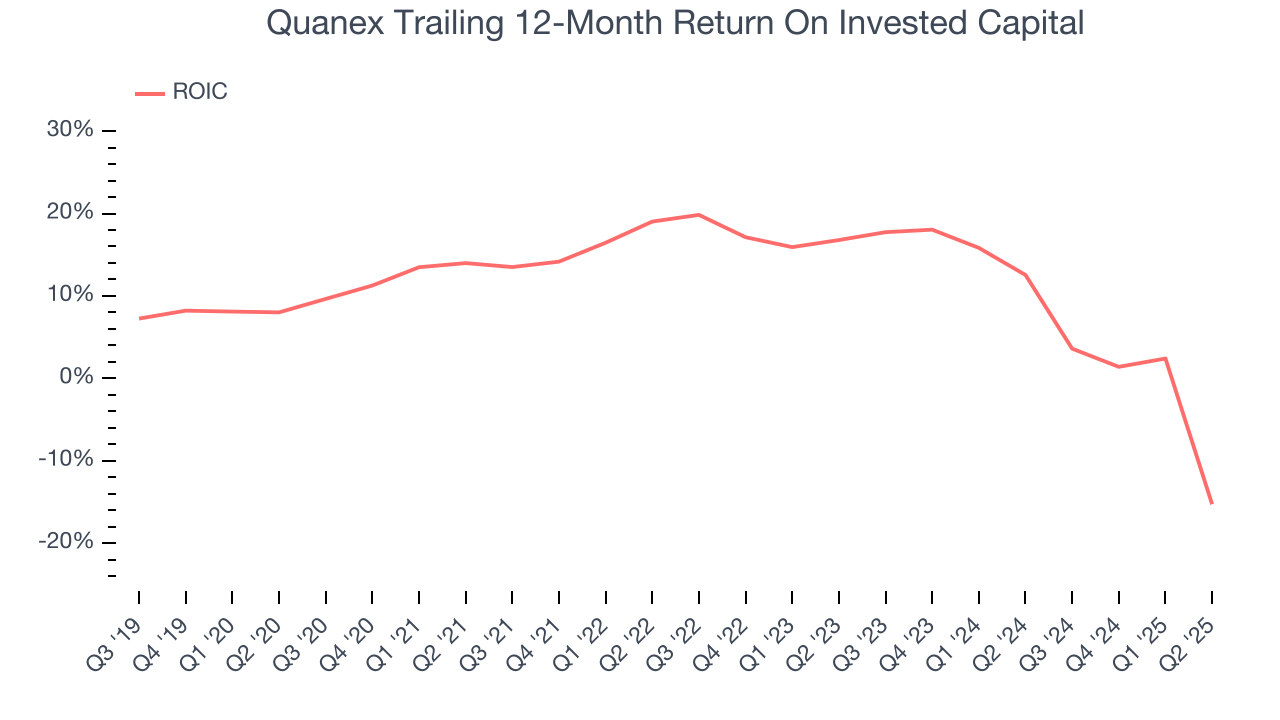
We like to invest in businesses with high returns, but the trend in a company’s ROIC is what often surprises the market and moves the stock price. Over the last few years, Quanex’s ROIC has unfortunately decreased significantly. Paired with its already low returns, these declines suggest its profitable growth opportunities are few and far between.
11. Balance Sheet Assessment
Quanex reported $66.27 million of cash and $875.4 million of debt on its balance sheet in the most recent quarter. As investors in high-quality companies, we primarily focus on two things: 1) that a company’s debt level isn’t too high and 2) that its interest payments are not excessively burdening the business.

With $251.8 million of EBITDA over the last 12 months, we view Quanex’s 3.2× net-debt-to-EBITDA ratio as safe. We also see its $29.6 million of annual interest expenses as appropriate. The company’s profits give it plenty of breathing room, allowing it to continue investing in growth initiatives.
12. Key Takeaways from Quanex’s Q2 Results
We were also happy its revenue narrowly outperformed Wall Street’s estimates. On the other hand, its full-year revenue was lowered. Additionally, full-year EBITDA guidance missed and its EBITDA fell short of Wall Street’s estimates. Overall, this was a softer quarter. The stock traded down 14% to $17.95 immediately following the results.
13. Is Now The Time To Buy Quanex?
Updated: December 4, 2025 at 10:12 PM EST
When considering an investment in Quanex, investors should account for its valuation and business qualities as well as what’s happened in the latest quarter.
Quanex’s business quality ultimately falls short of our standards. Although its revenue growth was exceptional over the last five years, it’s expected to deteriorate over the next 12 months and its diminishing returns show management's prior bets haven't worked out. And while the company’s spectacular EPS growth over the last five years shows its profits are trickling down to shareholders, the downside is its projected EPS for the next year is lacking.
Quanex’s P/E ratio based on the next 12 months is 7x. While this valuation is optically cheap, the potential downside is big given its shaky fundamentals. We're fairly confident there are better stocks to buy right now.
Wall Street analysts have a consensus one-year price target of $28 on the company (compared to the current share price of $13.65).
Although the price target is bullish, readers should exercise caution because analysts tend to be overly optimistic. The firms they work for, often big banks, have relationships with companies that extend into fundraising, M&A advisory, and other rewarding business lines. As a result, they typically hesitate to say bad things for fear they will lose out. We at StockStory do not suffer from such conflicts of interest, so we’ll always tell it like it is.

